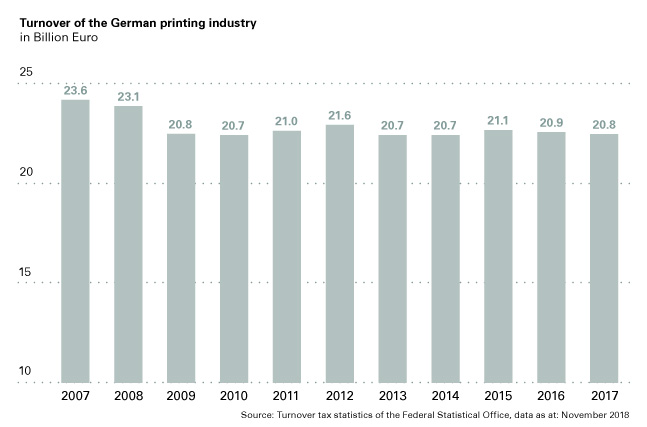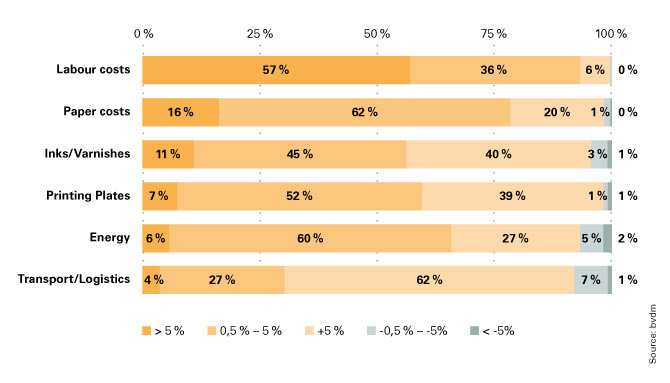The parameters of the printing industry have changed in the past few years: The digital printing sector is growing fast. Many print businesses are reporting shorter print runs. The competitive pressure – especially with regard to print quality, delivery times and pricing – Is growing.
However, one parameter has settled at a stable level over the past 10 years: the turnover of the industry. Since 2009, sales in the US printing industry have been around 80 000 million USD per year. Similar trends can be seen in the German market. There, sales have leveled out at almost 21 billion euros per year since 2009.

Due to changed customer requirements and a growing online print market the print runs per job are becoming shorter. These two facts lead to the following conclusion: in order to achieve the same volume with smaller print runs, the number of orders must increase.
How can print businesses survive in the market, manage the growing number of short-run jobs and increase their profits?
1) With printing and finishing machines getting quicker, the bottleneck occurs in pre-press. With the increasing number of jobs and the decreasing quality of incoming files people working in pre-press are constantly under pressure. Bringing additional staff in or managing peaks with temps is an expensive undertaking.
2) Especially since the wages are rising. 3) The number of print business has been declining. Competition is fierce. Crowding out is happening. Those print businesses that deliver their customers with high-quality print products within few hours while at the same time saving their margins through a high level of automation stay ahead of the competition and increase their profitability.
3) The number of print business has been declining. Competition is fierce. Crowding out is happening. Those print businesses that deliver their customers with high-quality print products within few hours while at the same time saving their margins through a high level of automation stay ahead of the competition and increase their profitability.
4) End customers expect low prices for print products and quick delivery times. If jobs need to be touched manually, the margin is gone.
5) Speed: Shorter production times ensure shorter delivery times. Your customers will have an appreciation for short delivery times.
6) High-speed machines paired with a manual work force in pre-press? Automating print file preparation will maximise the ROI of your equipment! If press doesn’t need to wait for pre-press to get the files print-ready, machine utilisation will increase.
7) This at the same time means then: more revenue! Shorter turnaround times give print business the chance to get more jobs done.
8) Decrease cost: Due to rule-based automation and the parameters of each print job, files get prepared automatically – reducing errors, mis- / reprintings.
9) Excel in customer service: Free up your staff to consult and delight customers in order to increase customer satisfaction and loyalty
10) Change your production KPIs for the better: Automating your workflow and your print file preparation helps you to score points in many ways. It’ll
a. decrease time spent per job
b. increase throughput
c. maximise press utilisation
d. optimise print file quality
e. and more
Let’s do the math real quick:
Prepress staff repair bleed, page formats, convert RGB images, nest and tile subjects, create cut lines and and and... manually. All these tasks can be automated based on the job properties and on rules. Rule-based automation does it all in a matter of minutes, not hours or days.
Let's assume
• the hourly rate is 25 GBP
• it takes 20 minutes to process a file manually
• This results in costs of 8 GBP per file
• With 30 files to be processed per day, this amounts to
Savings of:
£240 per day,
More than £4,800 per month
Over £57,000 per year
Automation Software does the job in a fraction of the time. In addition, it should be noted that only the savings made by the pure work on the file are taken into account here. Software also automates the transfer of the order to production and again the transfer of production to printing and finishing.
If you want to survive in the long term and be profitable, you have to face the changing market conditions and act successfully. The Darwinian principle “Survival of the Fittest” applies. The strongest will win. Or in the figurative sense: The courage to change will be rewarded.







